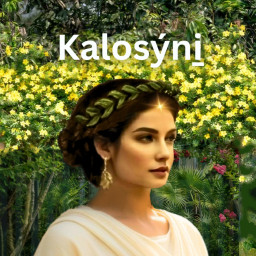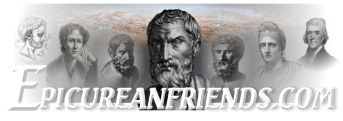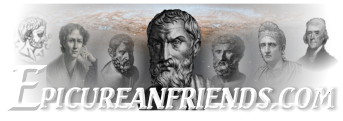Rings exist featuring Epicurus and Lucretius (one known to exist).
Rings, Tokens, and Pendants Featuring Epicurus or Epicureans
-
-
I thought we had some photos in this thread. Here are some of Epicurus (stamp is for comparison)
-
Here is the best photo I have of the probable Lucretius Ring (probably the one described by Munro):
-
-
It's notable that all of the Epicurus images are in ellipses, not circles. Apparently Joshua isn't the first to face the problem of putting a long, bearded head into a circle.
-
That is a point of interest, Godfrey. The 18th or early 19th century William Bligh ring is more squat and nearly circular than the rings above from antiquity, and it's also the worst semblance. In part because the beard has been cropped so close.
-
And here's something before I forget; in my search for extant rings I didn't turn up anything new on Epicurus, but there is supposed to be a ring featuring a portrait of Horace carved in Topaz in the collections of the British Museum. So it would be great if we could track down a photograph of that.
-
Wow yes that is interesting about Horace. I have never heard of that. I wonder how it is they are confident it is Horace vs. someone else? We definitely ought to try to trace that down.
So far no luck with this search:
https://www.britishmuseum.org/collection/sea…ce&keyword=ring
-
I'll try to find the reference, Cassius; it was in a GoogleBooks scan of an old doorstopper reference tome called--I don't know--"Collections of the British Museum: Volume 47" or whatever. The British Museum is like an iceberg. For every one piece on display for public viewing, 99 are gathering dust in a drawer somewhere.
-
OK, I found the reference;
"A Popular Handbook to the Greek and Roman Antiquities in the British Museum"
edited by Sir Edward Tyas Cook
-
No picture yet but:
https://books.google.com/books?id=M0RAA…0Horace&f=false
I wonder if this was done per the ring:
https://www.britishmuseum.org/collection/object/P_1914-0228-2525
-
I couldn't see if anyone had mentioned this before, so apologies if I'm repeating known info: I saw the Greek on several Epicurus rings and realized that was not Epicurus' name but ΝΕΑΡΚΟΥ (Nearkou, "Of Nearkos"). Who was Nearkos? Turns out he was probably the engraver:
QuoteNEARKOS (Νέαρκος). - Alleged gem engraver. The name, which appears on three gems (ΝΕΑΡΚΟΥ on a carnelian with a manly head; ΝΕΑΡΚΟΣ on an amethyst with a manly bearded head; ΝΕΑΡΚΟΥ on a carnelian, of doubtful authenticity, with a manly head) cannot, according to Brunn, be attributed to 'engraver.
Source (used Google Translate for English)
-
I remember reading that on one of the pages too somewhere - that NEAPKOY was the engraver, so that's what I am thinking too. Although I sometimes do have doubts whether the images that some say are Epicurus are really him. Some of the images can seem so generic that it's hard (for me) to be sure.
-
Handbook of Archaeology: Egyptian-Greek-Etruscan-Roman:
https://books.google.com/books?id=TLRGA…ngraver&f=false
Nearkos is listed here amongst other ancient artists. Also attributed to him are images of Sulla and Demetrius, which I suppose is how they date the gems?
-
I found a series of prints used for gem engravings in the British Museum, it dates back to 1766 and features 180 different prints with reference to Greek & Roman Figures as well as some mythological/animal prints, Horace is among them.
https://www.britishmuseum.org/collection/obj…9-0709-891-1071
-
Interestingly enough, I went through the rest of the collection and found a feature of Epicurus as well as one on Metrodorus, though Hermarchus & Leontion were nowhere to be found.
I don't have any reason to believe that the print of Metrodorus is none other than Metrodorus the Younger. There have been other Metrodorus' throughout history but none have been as significant or recorded as much as the disciple and best friend of Epicurus, no doubt because of Laertius and Cicero. -
i wonder if there was any basis for any of those other than artist imagination. The one of Horace looks like a boy - is it likely that any image of him survived the ancient world other than as am adult?
The one of Epicurus is the clearly erroneus "bald" figure that hardly seems like it could be anything other than imagination.
Is the Metrodorus any better?
Apparently artists from this period seemed to think it a cool thing to do to make artwork based on nothing whatsoever and label them as if they were accurate?
That image of Lucian on the Wikipedia page seems to be another example.
Seems to me to be a weird thing to think that such use of imagination was a good idea.
On the same theory Joshua could decide to sketch one of his girlfriends and label it "Leontion"
Hardly seems like a good idea, but maybe I just lack imagination

-
I agree with Cassius that these portraits leave a lot to be desired, but that's a good find regardless. Thank you Charles!
The portrait of Horace is especially interesting. He is depicted not only as a boy, but as a free-born minor wearing the age-appropriate Toga Praetexta. Horace was free-born, which is a point worthy of note since his father endured some years of slavery.
He is also depicted with a bay leaf (or laurel, from bay laurel), which signifies poetry. In fact, Horace did not write poetry in his youth; he turned to it in later years after choosing the wrong side in the Roman Civil War and losing his father's estate in Venusia as part of Augustus' land seizures. Since Rome did boast a number of boy-poets--among them Lucan, died age 25, and Catullus, died age 30--it might seem an unusual choice for a portrait of Horace who lived to be nearly 60. Personally, my favorite portrait of Horace depicts him bald and squat, in middle age, with a glass of wine and a winning grin.
-
Yes I have seen and like that one too. Is that from the wikipedia page? I agree that one is really creative and well done, I wish we had information on its background.
-
These are the "necklace" molds I referenced last night (with a drachma of Demetrius Poliorcetes for scale). It's an amateur effort -- the most recent one is almost bubble free! But if anybody wants some, just let me know and I'll be happy to gift a few of them (along with a Demetrius drachma).
-

Kalosyni
October 3, 2024 at 2:38 PM Changed the title of the thread from “Rings Featuring Epicurus or Epicureans” to “Rings, Tokens, and Pendants Featuring Epicurus or Epicureans”. -
Finding Things At EpicureanFriends.com
Here is a list of suggested search strategies:
- Website Overview page - clickable links arrranged by cards.
- Forum Main Page - list of forums and subforums arranged by topic. Threads are posted according to relevant topics. The "Uncategorized subforum" contains threads which do not fall into any existing topic (also contains older "unfiled" threads which will soon be moved).
- Search Tool - icon is located on the top right of every page. Note that the search box asks you what section of the forum you'd like to search. If you don't know, select "Everywhere."
- Search By Key Tags - curated to show frequently-searched topics.
- Full Tag List - an alphabetical list of all tags.

